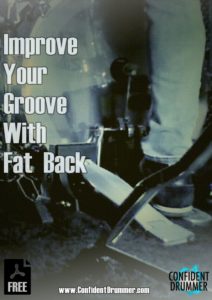I always say that there are some things that are essential to being good drummers.
Groove is definitely one of these aspects, maybe the most important. We may not even know how to properly hold the sticks, but, if when we start playing there is groove, it’s all good.
Groove is when there is such consistency of timing, feeling, and technical accuracy, that the listener can relax, let go and just enjoy the sensations created by what we play, because everything is so smooth and there will be no surprises or sudden variations.
Being able to play even simple rhythms in this way can be a lot more difficult than it seems.
Talking about groove, the Fat Back is definitely one of the most important techniques we can study to improve it and even master it.
In the word Fat Back, “fat” in American slang means full, large, juicy, solid, important.
And “back” is the diminutive of Backbeat, which is the accented note played on 2 and 4 on the Snare, in the rhythms of contemporary music.
Since the Fat Back is based on spending a long time on each possible position of one or more Bass Drum notes within a beat, its positive side effect is that it also helps us with Bass Drum control and technique, and with coordination with the upper limbs.
It also makes us develop our Hi-Hat strength and Snare Drum Rimshots consistency. Lots of good stuff 😉
These examples focus on eighth note groves: we are going to practice all possible combinations of 1, 2 and even 3 consecutive Bass Drum hits within a quarter note (on a 16th note grid). The same studies are played both with a straight feel and with a shuffle feel.
In the YouTube Video Demo I play each exercise at 80 bpm.
And you can click here for the 10 Page interactive Pdf:
We can further extend the concept in many ways: by applying Hi-Hat variations (like the ones shown in the exercises), by adding ostinatos to the right hand, by playing at various dynamic levels, and particularly by using the same method with 16th note rhythms, triplet based beats, and even 6/8 grooves.
By doing this, in the future no Bass Drum pattern will ever be too challenging for us.
This is a must have skill for any serious drummer, and it has a huge impact on how solid our groove and timing are.
It’s crucial to keep in mind that the most important technical aspects to focus on is the coordination and the flawless alignment between the hands and the Bass Drum. Flams are much more evident at very low speeds.
So, to begin with, they need to be cleaned up at low tempos.
Let’s start as usual very slowly, at 60 bpm. Then we can try to speed up as much as we like, keeping in mind that it’s about accuracy, feel, and staying relaxed.
Recording ourselves and listening to our performance is going to be really helpful with these studies.
Having great groove takes lots of patient work, which involves spending a long time on each example, being aware of all the details and fixing any imperfection.
If you like this kind of studies and feel like boosting your grooving skills, you can find all the tools you need in the two Confident Drummer methods entirely focused on this key topic:
‘Groove Workout & Tools’ – Altitude Drumming – Volume 7
‘Groove Mastery & Formulas’ – Altitude Drumming – Volume 8



















